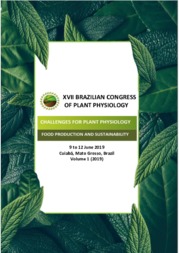Relationship between the physiological and agronomic variables of soybean in the ICLF systems.
Relationship between the physiological and agronomic variables of soybean in the ICLF systems.
Author(s): CARVALHO, G. de; BEHLING, M.; SILVA, A. C. da; FELIPE, R. T. A.
Summary: Land-use optimization is the main benefit of integrated crop-livestock-forest (ICLF) systems. However, one of the major challenges for the use of integrated systems is the understanding of the interactions that occur between the agriculture and forage components with the forest component, that is, with the shade. Thus, the objective of the study was to evaluate the effect of the tree component in ICLF systems on the relationship between physiological and agronomic variables in soybean crops, 4 years after system implementation. The evaluated systems were: 1) exclusive soybean crop, and 2) ICLF, eucalyptus crops planted in triple rows (3.5 m x 3 m), in the East-West direction, spaced 30 meters away from each other, and annually grown between soybean rows. The experiment followed a randomized block design, with three repetitions. Leaf dry mass (LDM), leaf area index (LAI), specific leaf area (SLA), photosynthesis (A), stomatal conductance (gs), chlorophyll (a and b), plant population and soybean yield were evaluated. The relationship between physiological and agronomic variables was tested through simple correlation matrix. Soybean yield showed positive correlation to plant population (r = 0.924), LDM (r = 0.963), LAI (r = 0.878) and gs (r = 0.891). On the other hand, SLA showed negative correlation to yield (r = - 0.929*) and LDM (r = -0.917 *), i.e., larger SLA did not result in higher yield. Larger SLA did not increase LDM, because plants grown in the shade present expanded and thinner leaves, besides investing in photoassimilates to increase the leaf area in order to maximize light absorption; this process leads to lower leaf mass density. The expansion in the leaf area did not increase crop yield, fact that confirmed the negative correlation between the variables. The photosynthetic rate presented a negative correlation with chlorophyll a and no correlation with chlorophyll b, a different result than expected, since the proportion of chlorophyll, especially b, increases in shaded environments due to higher production of light-collecting pigments that result from low radiation. Thus, ICLF systems present changes in the relationship between physiological variables and yield, especially in cultivated soybean plants close to the trees.
Publication year: 2019
Types of publication: Abstract in annals or event proceedings
Keywords: Eucalyptus, Glycine Max, Leaf area
Observation
Some of Embrapa's publications are published as ePub files. To read them, use or download one of the following free software options to your computer or mobile device. Android: Google Play Books; IOS: iBooks; Windows and Linux: Calibre.
Access other publications
Access the Agricultural Research Database (BDPA) to consult Embrapa's full library collection and records.
Visit Embrapa Bookstore to purchase books and other publications sold by Embrapa.

